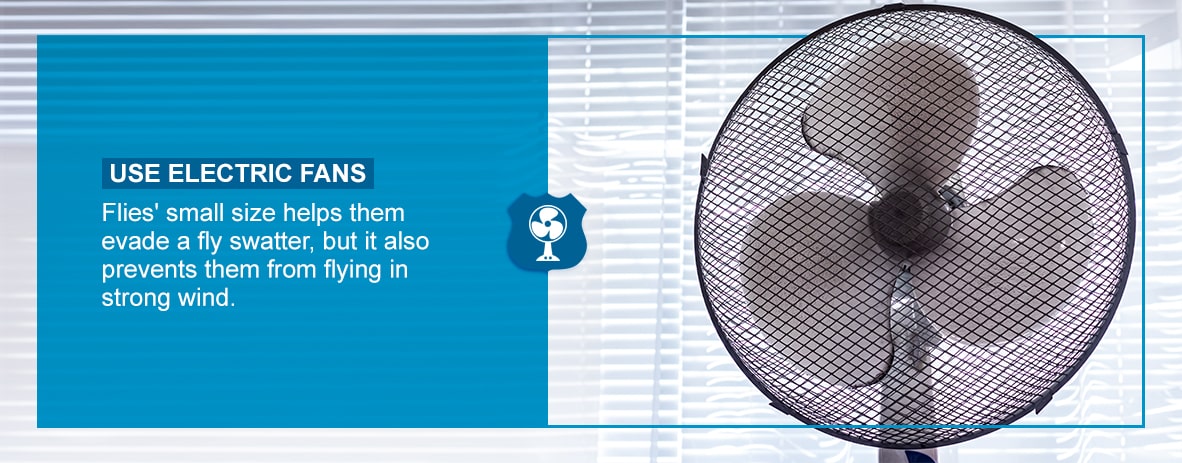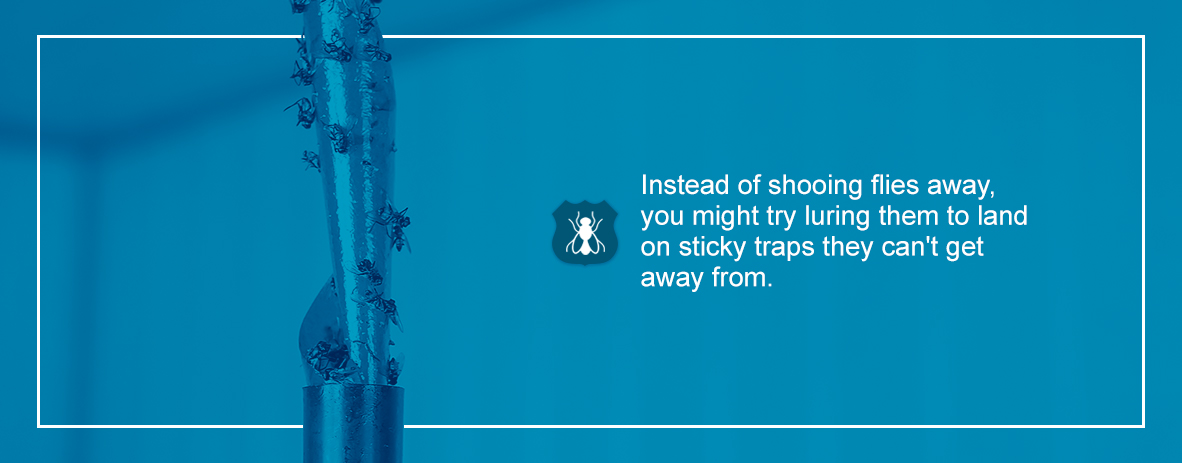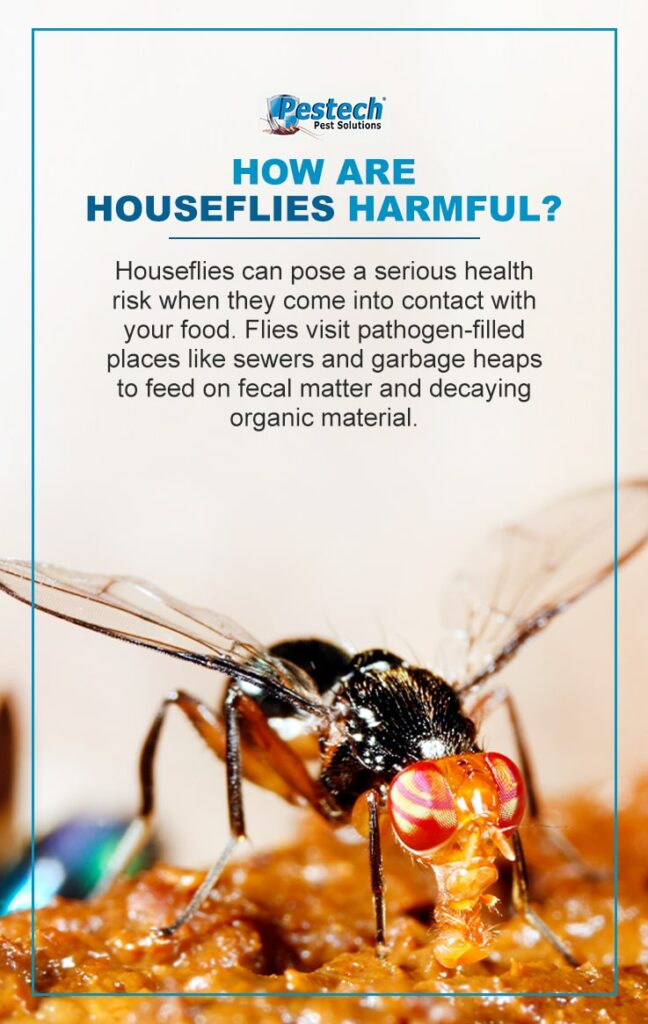How to Keep Flies Away From Food
How to Keep Flies Away From Food
Sharing an outdoor meal with friends and family is an enjoyable and unique experience — except when buzzing house flies crash the party. It’s hard to relax and have fun when you’re distracted by the flies circling your head and plate of food. Instead of engaging in conversation and enjoying the weather, you’re left wondering whether the food on your plate is safe after a fly landed on it.
Your concerns are valid. Flies are more than just a nuisance — they carry and spread numerous pathogens that threaten human health. When dining outdoors, it’s important to be aware of how flies pose risks and to limit their contact with you and your food.
Tips for Keeping Flies off Your Food
- Reduce Breeding Environment
- Use Fans in Your Dining Area
- Cover Food and Eliminate Trash
- Keep Your Trash Bins Clean
- Seal Off Enticing Drinks
- Use Bug-Repelling Plants
- Use Bug Repellant
- Use Essential Oils and/or Candles
- Set Sticky Traps
- Use Natural Repellants
- Treat with Insecticides
- Make DIY Fly Traps
There are many methods of fly pest control based on the insect’s biology and behavior that work more consistently than swatting at the bugs. Fly management includes a few distinct categories, including sanitation, exclusion, chemical control and non-chemical measures. Here are several effective tips for keeping flies away from you and your outdoor party:
1. Reduce the Breeding Environment
One of the first ways to prevent fly problems is to eliminate their breeding grounds. Flies lay eggs in rotting organic material — such as dead animals, decaying vegetation and food byproducts — where the larvae can feed and develop into adults. If you keep a garden, be sure to harvest promptly or relocate your garden away from your yard and patio.
Compost piles, while environmentally friendly, contain a high concentration of decaying vegetation and may serve as breeding grounds for flies. Well-managed compost piles generate heat that deters flies and minimizes their survival, but you may still have a fly problem around your compost pile. One solution is to cover your compost pile with a black plastic barrier, which serves as physical protection and traps more heat to keep flies away.
You can also control the available breeding environment by picking up after your pets. Fresh animal feces attracts flies and can even provide a home for fly larvae. Consistently cleaning up after your pets, especially dogs and horses, can take away the breeding ground and food source for flies.
2. Use Electric Fans in Your Dining Room
Flies’ small size helps them evade a fly swatter, but it also prevents them from flying in strong wind. You can set up electric fans around your dining area to create a no-fly zone around your food. Alternatively, if you have a covered porch or patio, you can install an overhead ceiling fan for a similar effect.
Using electric fans is an excellent non-chemical method of control that helps keep flies off your food while also cooling you down in the hot summer months. If you prefer a more direct approach, you can also use an electric fly swatter to eliminate individual flies.

3. Cover Food and Eliminate Trash
Outdoor eating means food will be exposed, and flies will be attracted to food scraps and open containers. You can minimize your barbecue’s attractiveness by covering foods when you’re not serving or consuming them and placing trash in garbage cans away from the event. Be especially mindful of foods high in sugar like fruits, sauces and desserts, as these are sure to attract flies.
Covering food and eliminating trash is a simple, common-sense measure that reduces the number of flies bothering you and your guests. It can also prevent flies from landing on your food and potentially spreading disease.
4. Wash Your Garbage and Recycling Cans
Since trash is one of the highest attractors of flies, the cans where you store your garbage will also attract them. While most people don’t think about their empty trash cans being an issue for attracting these pesky bugs, the leftover smells and garbage can still attract fruit flies. Since many people store their garbage cans next to their house, a pest issue there can mean flies bothering you during your outdoor meal.
If you want to eliminate the issue of flies surrounding your recycling and garbage cans, you can rinse them with water from a hose. Place the empty bins on their side and rinse the inside clean of any leaked garbage. Just be careful to collect any trash to avoid littering your yard and local storm drains. For an especially messy can, you can buy or rent a power washer to give it a deep cleaning.
When you wash your garbage cans, also be sure the rinse water doesn’t drain into nearby grass or soil, as flies can breed in soil rich in organic material. While this may be a messy job, you’ll see an instant improvement in the smell around your garbage cans and notice fewer flies if you practice this tip regularly. Additionally, you can avoid flies by tightly tying your garbage bags, ensuring your garbage can lid fights tightly, keeping garbage cans far from your home and emptying the cans regularly.
5. Mind the Drinks
Another way to help get rid of flies at your picnic is to mind your drinks. Flies seek out sources of sugar and are particularly attracted to carbon dioxide produced by the fermentation of decaying fruits and vegetables. Unfortunately, this attraction also includes any kind of sweet, carbonated beverage at your outdoor picnic. You can reduce the number of bothersome flies by sealing open containers of soda, beer and wine when you’re not pouring them. Also, be sure to immediately wipe up any sticky spills on your outdoor table.
6. Grow Bug-Repelling Plants
Certain plants can act as natural bug-repellant if you keep them near your outdoor dining area. For example, you could place basil plants on your dining table to keep the flies away and make the setting smell great. Lavender, peppermint, pine and thyme are other herb garden staples that keep insects away while offering a pleasant scent. Try making a bouquet of these herbs and use them as a centerpiece at your next picnic or barbecue.
You can also consider buying carnivorous plants, such as Venus’ flytraps or pitcher plants, to reduce the number of flies interrupting your outdoor party. These plants naturally eliminate flies by preying on them and make a great conversation starter with their distinctive looks.
7. Wear Bug Repellant
You’ve probably worn mosquito repellant while hiking or on vacation, but there are also repellants available for flies. Insect repellants use various active ingredients, including DEET, picaridin and oil of lemon eucalyptus. You can try wearing fly repellent while dining outdoors to keep flies away from you and your meal. If you dislike the smell of bug spray, try a natural bug repellant that uses essential oils from herbs like mint, rosemary, lavender and basil.
8. Use Essential Oils and Candles
Essential oils from the fly-repelling herbs mentioned above can also be used in different forms. You can purchase electronic scent diffusers, fill them with essential oils and place them around your outdoor dining area to ward off flies. Similarly, you can buy candles made with essential oils and use them to add charm to your event while keeping flies off everyone’s meals.
9. Set Sticky Traps
Instead of shooing flies away, you might try luring them to land on sticky traps they can’t get away from. Sticky traps offer the advantages of not emitting unpleasant odors and not requiring any effort on your part. Using pheromones, these fly traps attract nearby flies to a sticky glue pad that prevents them from getting away. Sticky traps aren’t harmful to you or your pets, so they may be the right fly management option for your needs.

10. Use Natural Repellants
If you’re looking for temporary fly repellants that won’t harm your pets or children if they happen to get a hold of them, try some of these natural solutions:
- Cayenne pepper: Mix cayenne pepper and water in a spray bottle and spray the concoction around doorways and areas where flies tend to gather. The potency of the cayenne will deter flies — and won’t harm you or your family if you accidentally ingest it.
- Lemon and clove: Place 20 to 25 cloves inside of a few lemon halves and leave them on the kitchen table and counter or anywhere else you keep food. Flies hate the scent of both these ingredients, so they’re a perfect way to deter them from partaking in your meal.
- Eucalyptus oil: Hang strips of cloth dipped in eucalyptus oil near doors and windows you use frequently. Eucalyptus oil confuses a fly’s senses, so these insects will steer clear of the smell.
11. Treat With Insecticides
You can suppress fly populations in and around your home by using insecticides in the form of sprays, baits and pest strips. If you’re hosting an outdoor event on your patio or near your house, treating your doorways and window frames with chemicals can help reduce your problems with flies. If you choose to use chemical control, a licensed pest control professional should inspect your home and apply the insecticides properly.
12. Make DIY Fly Traps
If you enjoy crafts and can’t stand the smell of fly repellent, consider making your own DIY fly traps. There are several types of fly traps you can make with common household materials, such as spare jars or bottles, wire, vinegar, oil, yeast, syrup and honey:
- DIY flypaper: You can make your own sticky trap with pieces of thin plastic — such as strips cut from a grocery bag — and a sugary substance like honey or syrup. Just cover the plastic strips with your chosen substance, allow them to dry and hang them up where flies are most active.
- Bottle funnel trap: Take empty two-liter bottles or other plastic containers and make a simple and inexpensive bottle funnel trap. Cut the top of the bottle just below the neck then invert it into the bottle as a funnel, using glue or tape to secure it. Fill the trap with sugar water, honey water, ripe fruit, vinegar or wine to attract flies into the funnel trap. For added assurance, add a drop of oil or liquid detergent to increase the surface tension and drown caught flies. This trap can be placed both indoors and outdoors.
- Disposable cup or container traps: Another simple fly trap makes use of disposable cups or plastic takeout containers. Fill the lidded container with apple cider vinegar and poke small holes that will allow flies inside. Once they enter, the flies will quickly drown in the vinegar. You can add petroleum jelly or oil to the inside of the container, which will cause flies to slip and fall more easily.
- Yeast trap: You can also make fly traps using yeast as bait. Partially fill a glass mason jar with warm but not boiling water and sprinkle in a package of activated dry yeast. Add a teaspoon of sugar to activate the yeast, then swirl the solution with a spoon. After a few minutes, the solution will start to foam and produce carbon dioxide. Cover the top of the jar with plastic wrap or a plastic bag, securing it with a rubber band, and poke a hole to allow flies through. After crawling into the jar, most of the flies will be unable to find their way out.

How Are Houseflies Harmful?
Houseflies can pose a serious health risk when they come into contact with your food. Flies visit pathogen-filled places like sewers and garbage heaps to feed on fecal matter and decaying organic material. They regurgitate and excrete wherever they come to rest, which results in the mechanical spread of disease from the dump to your dinner plate.
Flies spread up to 65 dangerous illnesses to humans, including cholera, dysentery, typhoid fever, poliomyelitis, tuberculosis, yaws, anthrax, tularemia and leprosy. A 2018 study identified over 130 pathogens in houseflies, including bacteria, viruses, parasites and fungi, all posing risks to humans and other animals. Flies are a major sanitation problem because of their constant movement between their breeding sites — full of decaying matter and bacteria — and human environments. Farms, cafeterias, restaurants, markets, landfills and hospitals are all vulnerable areas of human activity.
It doesn’t take more than several minutes for a fly to spread bacteria onto food. A 2019 study found that depending on the concentration of bacteria on the fly and the type of food it lands on, a fly can contaminate food with E. coli in as few as five to 10 minutes. Foods that are highly attractive to flies, such as apples and cakes, were the most susceptible to contamination.
The disease risks flies pose are supported by a large body of research and bear consideration if you’re dealing with a fly problem. Enjoying outdoor dining isn’t the only reason to get rid of flies in and around your home environment. In addition to keeping flies at bay with the above tips, you might need to contact experienced professionals in the pest-prevention industry.
Start With Fly Pest Prevention
Whether your fly problem is at home or at your business, the pest control experts at Pestech Pest Solutions have the experience and expertise to help. We offer annual risk assessment and routine monitoring based on your needs and budget to ensure your freedom from unwanted infestations. With over 25 years in the industry and reliable pest solutions, Pestech helps you live happily and healthily. Contact us to schedule an inspection or learn more about our pest management services.


